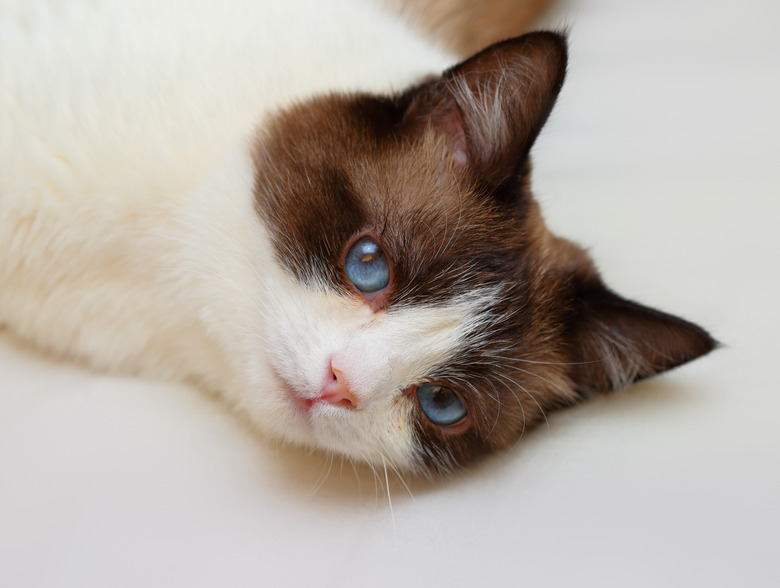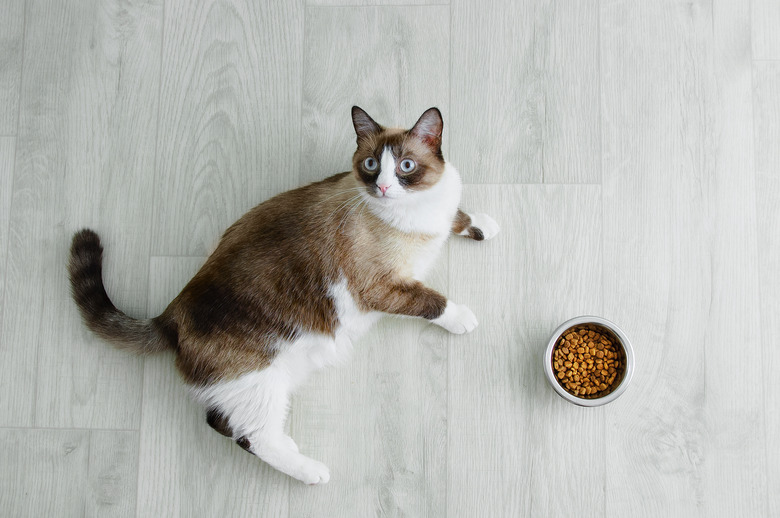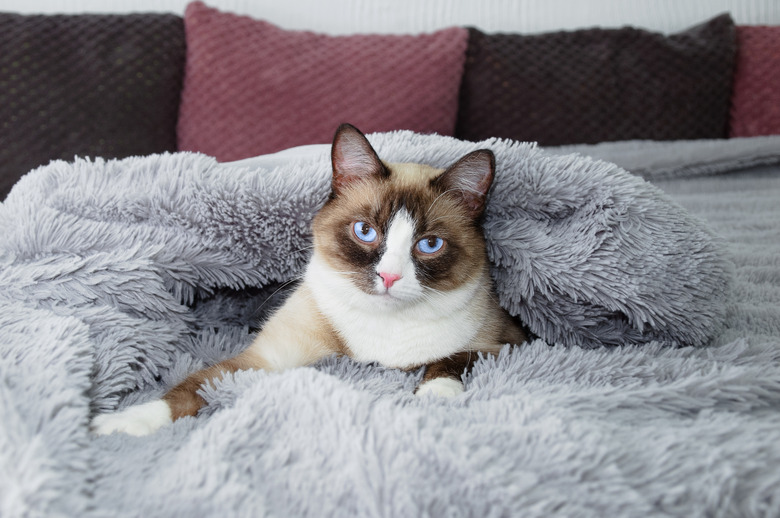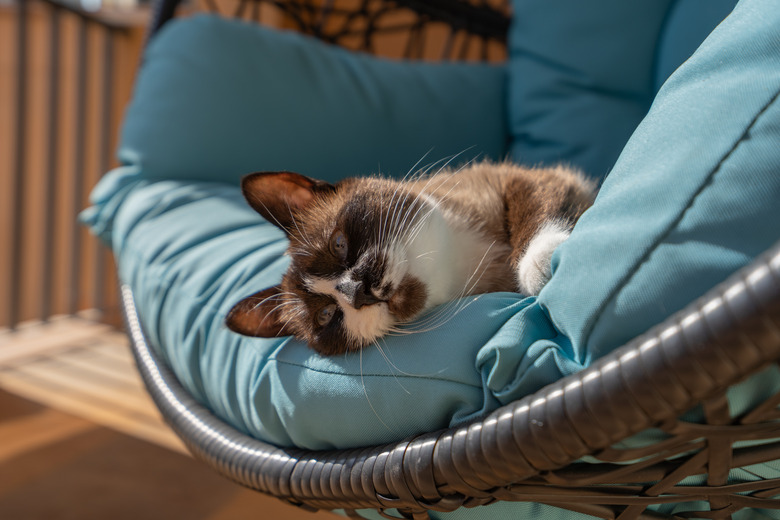Snowshoe Cat Breed Characteristics
Snowshoe cat quick facts
Snowshoe cat quick facts
Length: 12 – 18 inches
Weight: Females: 7 – 10 pounds, males: 9 – 12 pounds
Lifespan: 5 – 20 years or more
Coat length: Short
Coloring: Kittens are born white but they develop a colorpoint pattern after a few weeks. Adult cats have a pointed coat pattern, usually a seal point or blue point pattern, as well as white feet and blue eyes.
Grooming needs: Low
Friendliness: Breed alone is not an accurate predictor of individual cats' personalities. However, snowshoe cats are generally regarded as playful and loyal.
The snowshoe cat breed has a unique appearance with their beautiful colorpoint coat, blue eyes, and white mittens on all four paws. You may recognize the breed from famous cats like Dusty the Klepto Kitty and Burton the Cat. The most famous of all is Grumpy Cat, a mixed-breed cat who is likely part snowshoe. The cats make a wonderful choice for many people as they get along with all human and animal family members, but the breed isn't for everyone. Consider the snowshoe cat's personality and care requirements before deciding to bring a kitten into your family.
Snowshoe cat history
Snowshoe cat history
The snowshoe cat is a fairly new breed that was developed in the 1960s by Siamese cat breeder Dorothy Hinds Daugherty. She bred Siamese kittens and one of the litters had kittens with white paws. The white markings on the feet were considered a fault under the Siamese cat breed standard.
She decided to develop what is now known as the snowshoe cat breed with a colorpoint coat pattern and four white feet. This was the result of breeding the cats with American shorthair cats that had tuxedo markings. Another breeder, named Vikki Olander, also played a large role in developing the Snowshoe cat breed.
The unique coloring is the result of a recessive gene. Snowshoe kittens are born with a white coat and after a few weeks start developing a colorpoint pattern, which may not fully develop until the cat is two years old. Seal point and blue point are the most common coat colors, but some cats may also be lilac and chocolate. The cats have blue, walnut-shaped eyes.
The snowshoe breed of cat was originally called silver lace. The breed is not recognized by the Cat Fanciers' Association (CFA). However the American Cat Fanciers Association (ACFA), Cat Fanciers Federation (CFF), and the International Cat Association (TICA) all recognize the breed.
Snowshoe cat personality
Snowshoe cat personality
Snowshoe cats have personality traits from both their American shorthair and Siamese ancestors. They are playful, intelligent, and easy to train. You can teach them how to:
- walk on a leash
- play fetch
- complete feline agility courses.
Don't be surprised when they learn to open doors and cabinets. Be sure to use plenty of positive reinforcement to train the cats.
Not only can you teach the snowshoe cat tricks, but the cats are also somewhat dog-like in that they love water. While many cats avoid getting wet at all costs, the snowshoe cat will happily jump in the sink or tub.
Cats are also incredibly social and loyal. They generally get along will all members of the family, including children and other pets. Snowshoes are also quite vocal and will meow frequently. It is important that the snowshoe cat is not left alone for long periods of time as companionship is important to the breed's mental health and they may cause problems if they get bored and lonely.
Snowshoe cat lifespan and health issues
Snowshoe cat lifespan and health issues
Healthy snowshoe cats can live well into their teens and even 20s. The breed has few genetic health issues. In rare cases, cats may suffer from:
- hypertrophic cardiomyopathy: a heart condition that causes thickening of the heart wall. There is no cure for this disease, but the symptoms can be managed.
- polycystic kidney disease: a genetic condition that causes cysts to develop in the kidneys. It can be managed through diet, fluids, and medicine. However there is no cure for this disease.
Like their Siamese ancestors, snowshoe cats may also be born with a kinked tail or crossed eyes. Fortunately, these are cosmetic issues that don't affect the cat's health or lifespan.
Snowshoe cat grooming and care
Snowshoe cat grooming and care
The snowshoe cat has a short coat that is easy to groom. Brush the cat about once per week. More frequent grooming can be beneficial when a cat is shedding their winter coat. Other grooming tasks include:
- trim the cat's nails
- check and clean the cat's ears
- brush the cat's teeth with a toothpaste that is veterinarian approved for cats
Feed a high-quality commercial cat food as recommended by your veterinarian and make sure the cat always has access to clean drinking water. Have regular playtime with a snowshoe cat to keep them sociable and healthy.
Welcoming a new cat into your home
Welcoming a new cat into your home
Before bringing a new snowshoe kitten or cat into your home, make sure you cat-proof the home. This includes:
- remove poisonous plants
- secure toxic cleaning supplies
- put breakable objects in a safe location
- pick up rubber bands and other small objects that can harm your cat if eaten
This is especially important for this intelligent and curious breed — they are likely to get into everything around the home. Set up a secure room where you can welcome your new and get them adjusted. Set up their food and water, litter box, cat tree, and scratching post to help make the room feel like home.
Spend plenty of time in the room with your new cat, but be sure to allow the cat to explore on their own. When they are ready, they will come to you to cuddle or be petted. It is important not to rush the new cat. With patience and positive reinforcement, you will soon have a loving and trusting relationship with your new cat.
If you have other pets in the home, allow them to smell and meet each other through the door or a baby gate. This ensures that both animals have a positive experience. In general, snowshoe cats get along with other pets.
Once your new cat is comfortable with the new location and all of the members of the family, you can open the door and allow them access to more of the house. Before you know it, your loyal cat will be following you around the house — and talking to you throughout the day.



